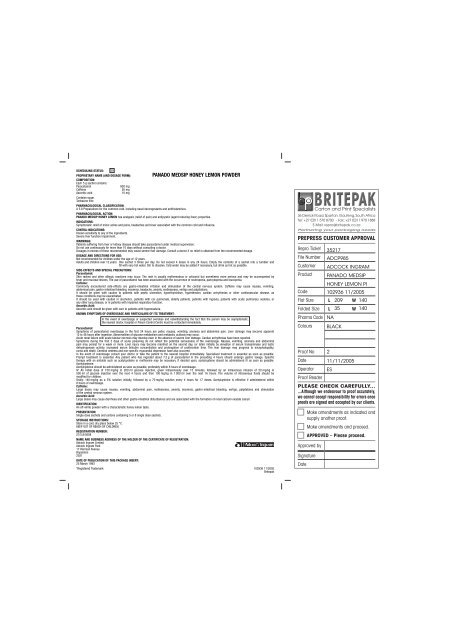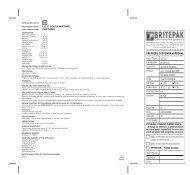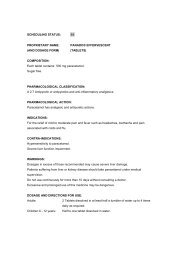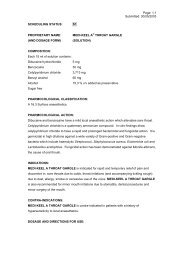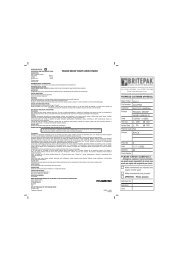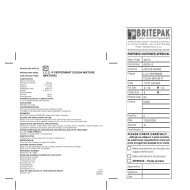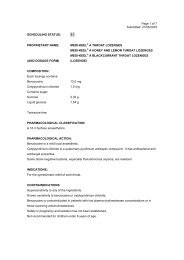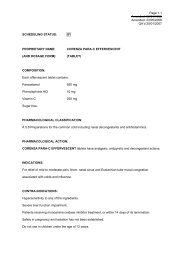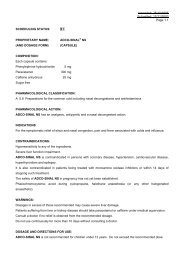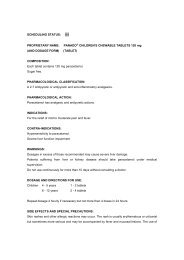Print Panado Medsip H-Lemon - Adcock Ingram | Colds & Flu
Print Panado Medsip H-Lemon - Adcock Ingram | Colds & Flu
Print Panado Medsip H-Lemon - Adcock Ingram | Colds & Flu
Create successful ePaper yourself
Turn your PDF publications into a flip-book with our unique Google optimized e-Paper software.
SCHEDULING STATUS: S0<br />
PROPRIETARY NAME (AND DOSAGE FORM): PANADO MEDSIP HONEY LEMON POWDER<br />
COMPOSITION:<br />
Each 5 g sachet contains:<br />
Paracetamol 800 mg<br />
Caffeine 50 mg<br />
Ascorbic acid 10 mg<br />
Contains sugar.<br />
Tartrazine free<br />
PHARMACOLOGICAL CLASSIFICATION:<br />
A 5.8 Preparations for the common cold, including nasal decongestants and antihistaminics.<br />
PHARMACOLOGICAL ACTION:<br />
PANADO MEDSIP HONEY LEMON has analgesic (relief of pain) and antipyretic (agent reducing fever) properties.<br />
INDICATIONS:<br />
Symptomatic relief of minor aches and pains, headaches and fever associated with the common cold and influenza.<br />
CONTRA-INDICATIONS:<br />
Known sensitivity to any of the ingredients.<br />
Severe liver function impairment.<br />
WARNINGS:<br />
Patients suffering from liver or kidney disease should take paracetamol under medical supervision.<br />
Do not use continuously for more than 10 days without consulting a doctor.<br />
Dosages in excess of those recommended may cause severe liver damage. Consult a doctor if no relief is obtained from the recommended dosage.<br />
DOSAGE AND DIRECTIONS FOR USE:<br />
Not recommended for children under the age of 12 years.<br />
Adults and children over 12 years: One sachet 3 times per day. Do not exceed 4 doses in any 24 hours. Empty the contents of a sachet into a tumbler and<br />
fill with very hot water. Stir to dissolve. Cold water may be added if necessary, but drink as hot as possible.<br />
SIDE-EFFECTS AND SPECIAL PRECAUTIONS:<br />
Paracetamol:<br />
Skin rashes and other allergic reactions may occur. The rash is usually erythematous or urticarial but sometimes more serious and may be accompanied by<br />
fever and mucosal lesions. The use of paracetamol has been associated with the occurrence of neutropenia, pancytopenia and leucopenia.<br />
Caffeine:<br />
Commonly encountered side-effects are gastro-intestinal irritation and stimulation of the central nervous system. Caffeine may cause nausea, vomiting,<br />
abdominal pain, gastro-intestinal bleeding, insomnia, headache, anxiety, restlessness, vertigo and palpitations.<br />
It should be given with caution to patients with peptic ulceration, hyperthyroidism, hypertension, cardiac arrhythmias or other cardiovascular disease, as<br />
these conditions may be exacerbated.<br />
It should be used with caution in alcoholics, patients with cor pulmonale, elderly patients, patients with hypoxia, patients with acute pulmonary oedema, or<br />
any other lung disease, or in patients with impaired respiratory function.<br />
Ascorbic Acid:<br />
Ascorbic acid should be given with care to patients with hyperoxaluria.<br />
KNOWN SYMPTOMS OF OVERDOSAGE AND PARTICULARS OF ITS TREATMENT:<br />
In the event of overdosage or suspected overdose and notwithstanding the fact that the person may be asymptomatic,<br />
the nearest doctor, hospital or Poison Control Centre must be contacted immediately.<br />
Paracetamol:<br />
Symptoms of paracetamol overdosage in the first 24 hours are pallor, nausea, vomiting, anorexia and abdominal pain. Liver damage may become apparent<br />
12 to 48 hours after ingestion. Abnormalities of glucose metabolism and metabolic acidosis may occur.<br />
Acute renal failure with acute tubular necrosis may develop even in the absence of severe liver damage. Cardiac arrhythmias have been reported.<br />
Symptoms during the first 2 days of acute poisoning do not reflect the potential seriousness of the overdosage. Nausea, vomiting, anorexia and abdominal<br />
pain may persist for a week or more. Liver injury may become manifest on the second day, (or later) initially by elevation of serum transaminase and lactic<br />
dehydrogenase activity, increased serum bilirubin concentration and prolongation of prothrombin time. The liver damage may progress to encephalopathy,<br />
coma and death. Cerebral oedema and non-specific myocardial depression have also occurred.<br />
In the event of overdosage consult your doctor or take the patient to the nearest hospital immediately. Specialised treatment is essential as soon as possible.<br />
Prompt treatment is essential. Any patient who has ingested about 7,5 g of paracetamol in the preceding 4 hours should undergo gastric lavage. Specific<br />
therapy with an antidote such as acetylcysteine or methionine may be necessary. If decided upon, acetylcysteine should be administered IV as soon as possible.<br />
Acetylcysteine:<br />
Acetylcysteine should be administered as soon as possible, preferably within 8 hours of overdosage.<br />
IV: An initial dose of 150 mg/kg in 200 ml glucose injection, given intravenously over 15 minutes, followed by an intravenous infusion of 50 mg/kg in<br />
500 ml of glucose injection over the next 4 hours and then 100 mg/kg in 1 000 ml over the next 16 hours. The volume of intravenous fluids should be<br />
modified for children.<br />
Orally: 140 mg/kg as a 5% solution initially, followed by a 70 mg/kg solution every 4 hours for 17 doses. Acetylcysteine is effective if administered within<br />
8 hours of overdosage.<br />
Caffeine:<br />
Large doses may cause nausea, vomiting, abdominal pain, restlessness, anxiety, insomnia, gastro-intestinal bleeding, vertigo, palpitations and stimulation<br />
of the central nervous system.<br />
Ascorbic Acid:<br />
Large doses may cause diarrhoea and other gastro-intestinal disturbances and are associated with the formation of renal calcium oxalate calculi.<br />
IDENTIFICATION:<br />
An off-white powder with a characteristic honey lemon taste.<br />
PRESENTATION:<br />
Single dose sachets and cartons containing 5 or 8 single dose sachets.<br />
STORAGE INSTRUCTIONS:<br />
Store in a cool, dry place below 25 °C.<br />
KEEP OUT OF REACH OF CHILDREN.<br />
REGISTRATION NUMBER:<br />
27/5.8/0508<br />
NAME AND BUSINESS ADDRESS OF THE HOLDER OF THE CERTIFICATE OF REGISTRATION:<br />
<strong>Adcock</strong> <strong>Ingram</strong> Limited<br />
<strong>Adcock</strong> <strong>Ingram</strong> Park<br />
17 Harrison Avenue<br />
Bryanston<br />
2021<br />
DATE OF PUBLICATION OF THIS PACKAGE INSERT:<br />
25 March 1993<br />
*Registered Trademark 102936 11/2005<br />
Britepak<br />
35217<br />
ADCP985<br />
ADCOCK INGRAM<br />
PANADO MEDSIP<br />
HONEY LEMON PI<br />
102936 11/2005<br />
209 140<br />
35 140<br />
NA<br />
BLACK<br />
2<br />
11/11/2005<br />
ES
SKEDULERINGSTATUS: S0<br />
EIENDOMSNAAM (EN DOSEERVORM): PANADO MEDSIP HONEY LEMON POEIER<br />
SAMESTELLING:<br />
Elke 5 g sakkie bevat:<br />
Parasetamol 800 mg<br />
Kafeïen 50 mg<br />
Askorbiensuur 10 mg<br />
Bevat suiker.<br />
Tartrasienvry.<br />
FARMAKOLOGIESE KLASSIFIKASIE:<br />
A 5.8 Middels teen gewone verkoue, verligting van neusverstopping en antihistaminika.<br />
FARMAKOLOGIESE WERKING:<br />
PANADO MEDSIP HONEY LEMON het analgetiese (pynstillende) en antipiretiese (koorswerende) eienskappe.<br />
INDIKASIES:<br />
Simptomatiese verligting van pyn, hoofpyn en koors wat gepaard gaan met gewone verkoue en griep.<br />
KONTRA-INDIKASIES:<br />
Bekende sensitiwiteit vir enige van die bestanddele.<br />
Ernstige lewerfunksie beskadiging.<br />
WAARSKUWINGS:<br />
Pasiënte wat aan lewer of niersiektes ly, moet parasetamol onder mediese toesig gebruik.<br />
Moet nie langer as 10 dae aaneenlopend gebruik sonder om ’n geneesheer te raadpleeg nie.<br />
Dosisse hoër as wat aanbeveel word, kan ernstige lewerskade veroorsaak. Raadpleeg ’n geneesheer indien geen verligting verkry word na die aanbevole<br />
dosis geneem is nie.<br />
DOSIS EN GEBRUIKSAANWYSINGS:<br />
Word nie aanbeveel vir kinders jonger as 12 jaar nie.<br />
Volwassenes en kinders ouer as 12 jaar: Een sakkie 3 maal per dag. Moenie meer as 4 dosisse binne 24 uur neem nie. Gooi inhoud van ’n sakkie in ’n glas en<br />
maak vol met baie warm water. Roer om op te los. Koue water kan bygevoeg word indien nodig, maar drink<br />
so warm as moontlik.<br />
NEWE-EFFEKTE EN SPESIALE VOORSORGMAATREËLS:<br />
Parasetamol:<br />
Veluitslag en ander sensitiwiteitsreaksies kan voorkom. Die uitslag is gewoonlik eritemateus of urtikaries, maar kan soms ernstiger wees en gepaard gaan<br />
met koors en mukosale letsels. Met die gebruik van parasetamol kan neutropenie, pansitopenie en leukopenie voorkom.<br />
Kafeïen:<br />
Newe-effekte wat algemeen kan voorkom is gastroïntestinale irritasie en stimulering van die sentrale senuweestelsel. Kafeïen kan naarheid, vomering, maagpyn,<br />
gastroïntestinale bloeding, slaaploosheid, hoofpyn, angs, rusteloosheid, duiseligheid en hartkloppings veroorsaak.<br />
Dit moet versigtig toegedien word aan pasiënte met peptiese ulserasie, hipertiroïdisme, hipertensie, kardiale aritmie of ander kardiovaskulêre siektes, aangesien<br />
die toestande kan vererger. Dit moet versigtig gebruik word deur alkoholiste, pasiënte met cor pulmonale, bejaardes, pasiënte met hipoksie, pasiënte<br />
met akute pulmonêre edeem of enige ander longsiekte of by pasiënte met verswakte respiratoriese funksie.<br />
Askorbiensuur:<br />
Askorbiensuur moet versigtig toegedien word aan pasiënte wat aan hiperoksalurie ly.<br />
BEKENDE SIMPTOME VAN OORDOSERING EN BESONDERHEDE VAN DIE BEHANDELING DAARVAN:<br />
In die geval van oordosering of vermoedelike oordosering en ondanks die feit dat die persoon dalk asimptomaties is, moet<br />
die naaste geneesheer, hospitaal of vergiftigingsentrum onmiddellik geraadpleeg word<br />
Parasetamol:<br />
Simptome van parasetamoloordosering in die eerste 24 uur is bleekheid, naarheid, braking, anoreksie en abdominale pyn. Simptome van lewerskade kan<br />
12 tot 48 uur na inname na vore tree. Abnormaliteite van glukose metabolisme en metaboliese asidose kan voorkom.<br />
Akute nierversaking met akute tubulêre nekrose kan ontwikkel selfs in die afwesigheid van ernstige lewerskade. Hartaritmieë is gerapporteer.<br />
Tydens die eerste 2 dae van akute vergiftiging word die potensiële erns van die oordosering nie deur die simptome uitgewys nie. Naarheid, braking, anoreksie<br />
en buikpyn kan vir ’n week of langer voortduur.<br />
Lewerbeskadiging kan na die tweede dag (of later) na vore tree, eerstens deur verhoging van serumstransaminase- en laktaatdehidrogenaseaktiwiteit,<br />
verhoogde serumbilirubienkonsentrasie en verlengde protrombientyd.<br />
Lewerbeskadiging kan aanleiding gee tot ensefalopatie, koma en die dood. Serebrale edeem en nie-spesifieke miokardiale onderdrukking het ook voorgekom.<br />
In die geval van oordosering, raadpleeg u geneesheer of neem die pasiënt onmiddellik na die naaste hospitaal. Gespesialiseerde behandeling is so spoedig<br />
moontlik noodsaaklik.<br />
Onmiddellike behandeling is noodsaaklik. Enige pasiënt wat ongeveer 7,5 g parasetamol in die voorafgaande 4 uur ingeneem het moet ’n maagspoeling<br />
ondergaan. Spesifieke terapie met ’n teenmiddel soos asetielsisteïen of metionien kan nodig wees. Indien daarop besluit word, moet asetielsisteïen so gou<br />
moontlik intraveneus toegedien word.<br />
Asetielsisteïen:<br />
Asetielsisteïen moet so spoedig moontlik toegedien word, verkieslik binne 8 ure na oordosering.<br />
Binneaars: ’n Aanvanklike dosis van 150 mg/kg in 200 ml glukose-inspuiting binneaars toegedien oor 15 minute, gevolg deur ’n binneaars infusie van<br />
50 mg/kg in 500 ml glukose-inspuiting oor die daaropvolgende 4 uur, daarna 100 mg/kg in 1 000 ml versprei oor die volgende 16 uur. Die volume van<br />
binneaarse vloeistowwe moet vir kinders aangepas word.<br />
Mondeliks: Aanvanklik 140 mg/kg as ’n 5% oplossing gevolg deur ’n 70 mg/kg oplossing elke 4 uur vir 17 doserings. Asetielsisteïen is doeltreffend indien<br />
dit binne 8 uur na oordosering toegedien word.<br />
Kafeïen:<br />
Oormatige dosisse kan naarheid, vomering, maagpyn, rusteloosheid, angs, slaaploosheid, gastroïntestinale bloeding, duiseligheid, hartkloppings en stimulering<br />
van die sentrale senuweesisteem veroorsaak.<br />
Askorbiensuur:<br />
Groot dosisse kan diaree en ander gastroïntestinale versteurings veroorsaak en word geassosieer met die vorming van renale kalsiumoksalaat kalkuli.<br />
IDENTIFIKASIE:<br />
’n Naaswit poeier met ’n karakteristieke heuning-suurlemoengeur.<br />
AANBIEDING:<br />
Enkeldosissakkies en houers wat 5 of 8 enkeldosissakkies bevat.<br />
BERGINGSAANWYSINGS:<br />
Bêre op ’n koel, droë plek benede 25 °C.<br />
HOU BUITE BEREIK VAN KINDERS.<br />
REGISTRASIENOMMER:<br />
27/5.8/0508<br />
NAAM EN BESIGHEIDSADRES VAN DIE HOUER VAN DIE SERTIFIKAAT VAN REGISTRASIE:<br />
<strong>Adcock</strong> <strong>Ingram</strong> Limited<br />
<strong>Adcock</strong> <strong>Ingram</strong> Park<br />
Harrisonlaan 17<br />
Bryanston, Uitbr. 77<br />
Bryanston, 2021.<br />
DATUM VAN PUBLIKASIE VAN HIERDIE VOUBILJET:<br />
25 Maart 1993<br />
*Geregistreerde Handelsmerk 102936 11/2005<br />
35217<br />
ADCP985<br />
ADCOCK INGRAM<br />
PANADO MEDSIP<br />
HONEY LEMON PI<br />
102936 11/2005<br />
209 140<br />
35 140<br />
NA<br />
BLACK<br />
2<br />
11/11/2005<br />
ES


